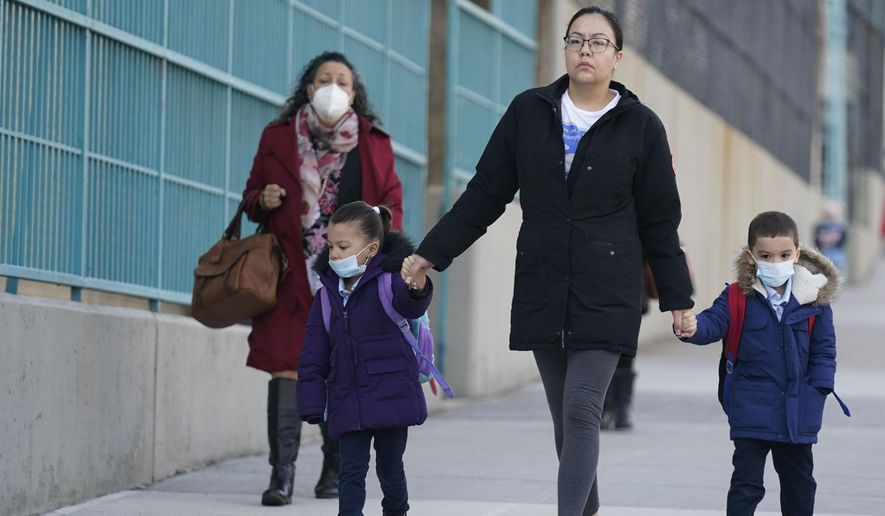COVID-19 is surging across the country and filling hospitals again, but leaders from coast to coast have bucked the return of mask mandates, signaling that on-again, off-again rules are no longer politically tenable and nearing extinction.
New York City Mayor Eric Adams, a Democrat trying to reinvigorate his hard-hit metropolis, bluntly rejected a return to mandates even as the city entered a “high” level of transmission risk, with an average of 4,000 cases per day in the past week compared to 3,300 in the past month.
“We’re not at the point of mandating a mask. We’re not at that point yet. We’re not at the point of doing anything other than urging New Yorkers, while you’re indoors, in large settings, social settings, wear your mask,” he told reporters this past week.
He explained the decision by saying the city has the tools to avoid a crisis within hospitals, signaling a catastrophic burden on the medical system would be the only trigger for mandates. The city hospitalization rate is relatively stable, averaging about 70 patients in both the past week and the last month.
“You are not seeing our hospitals going through the state of emergency that we were at,” the mayor said. “This is not the numbers like when we were starting out COVID. We’re not like that anymore, where hospitals were overburdened.”
New York officials are formally recommending masks in indoor spaces instead of resorting to heavy rules.
It’s an approach that is being replicated in blue states and cities across the country. Philadelphia briefly reimposed its mask mandate last month, only to lift it again within days, saying a strong recommendation seemed to work fine.
SEE ALSO: Experts see spike in divorce, single parenting amid COVID-19 stress
“Since the mandate piece didn’t seem to be necessary, we skipped the mandate and just kept the strong recommendation,” Philadelphia Health Commissioner Cheryl Bettigole told a Washington Post Live event last week. “I don’t want a mandate if we don’t need a mandate.”
Officials in Los Angeles and the Bay Area of California are strongly recommending masks but not mandating them, at least not yet.
Reticence to slap mandates back on reflects growing political pressure to ease off onerous rules and let people make their own decisions around COVID-19, particularly as Democrats face gripes over inflation and other crises ahead of the midterm elections.
Governors and mayors raced to lift virus rules in the early spring, citing declining case counts.
Yet the country faces another inflection point. A national surge is unfolding far ahead of the summer Sun Belt spike seen in July and August over the past two years.
Daily case counts are averaging more than 100,000 for the first time since February, fueled in part by omicron sub-lineages known as BA.2.12.1.
“They are driving a lot of the increases in infection that we’re seeing across the nation right now. And that is a huge challenge,” White House COVID-19 Coordinator Dr. Ashish Jha said at a midweek briefing.
U.S. hospitalizations have risen 31% in the past two weeks, to 23,000 patients nationwide, though it is far below pandemic peaks as widespread immunity and new treatments blunt some share of severe disease.
Policymakers are caught between experts and parents looking for caution — there still isn’t a vaccine for the youngest children — and those who vociferously reject government rules, including trucker convoys that clogged the Washington Beltway after Canadian truckers inspired protesters on this side of the border.
Courts have struck down other mandates, including the federal rule requiring masks on flights and other public transportation.
Taken together, some experts think the mask mandate is going the way of the dodo bird.
“I think it is, and I’m a proponent. I still believe in mandates in settings like nursing homes or high-risk settings where people have to work closely to one another,” said Arthur Caplan, director of the division of medical ethics at the New York University Grossman School of Medicine. “I think politicians have decided that mandates are a liability to defend, many people don’t like them. They’re seen as costing a lot of political capital and with elections looming, a lot of places are seeing their leadership surrender on mandates.”
Mandates aren’t completely dead. Some school districts in Pennsylvania and New Jersey, for instance, are bringing them back as cases surge.
New Jersey Gov. Phil Murphy recently said he is fine with school districts making their own decision on masks but hasn’t moved to issue a new state mandate.
Experts think mandates will slide, more and more, to the local level or be determined by individual colleges, unions and other organizations.
Even as New York City Mayor Adams bucks a return to citywide mandates, the Broadway League said Friday that all 41 of its theaters will extend mask rules at shows through the end of June.
“We’re thrilled that nearly a quarter of a million people are attending Broadway shows weekly in this exciting spring season,” league President Charlotte St. Martin said. “As always, the safety and security of our cast, crew, and audience has been our top priority. By maintaining our audience masking requirement through at least the month of June, we intend to continue that track record of safety for all, despite the omicron subvariants.”
Similarly, the Metropolitan Opera requires attendees to present proof of vaccination and wear a mask throughout the house except in designated eating and drinking areas. An usher politely tells people to put their masks back on as they leave the champagne area to enjoy the next act.
“I think mandates will mostly remain in the private sector, like theaters, concerts, colleges, and workplaces,” said Lawrence O. Gostin, a global health law professor at Georgetown University. “The courts have upheld business mandates but have been more skeptical of government mandates.”
For more information, visit The Washington Times COVID-19 resource page.
• Tom Howell Jr. can be reached at thowell@washingtontimes.com.




Please read our comment policy before commenting.